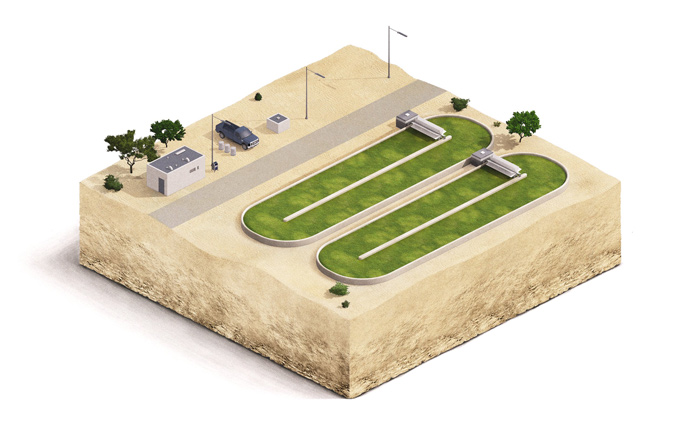
Marine algae are one of the most promising future sources of bioenergy and nutrients. This is due to their very efficient photosynthesis with consequent high surface yields, possibilities for using non-agricultural land and or seawater for cultivation, increased lipid content, very interesting molecular profiles for fuel production, and considerable potential for near-term technical improvements of cultivation systems.
There are many algae species that have a vast range of physiological properties and potential uses. Algae farms already exist to grow algae strains selected for their ability to concentrate or manufacture certain key nutritional elements; significant investments around the world are funding research to identify or breed optimal algae strains and to develop highly efficient cultivation and harvesting methods that make the manufacture of biofuels from algal oil profitable.
Algae are a natural fit into the SFP infrastructure, requiring as they do lots of sunlight and seawater, the two core inputs to the facility. One of the critical challenges for making the production of algal biofuels from microalgae profitable is enabling the production of saltwater algae in locations not located directly on the coast. Typically, coastal land is more expensive and often not zoned for industrial use, but the cost of transporting seawater inland for algae cultivation is prohibitive. Moreover, algae facilities require some 2 kg of CO2 for every kg of algae they generate. Maximizing growth rates in algal facilities, therefore, needs an external source of CO2 to be supplemented to the system. It would be highly advantageous if this CO2 could be sourced as a waste product from a nearby industrial process rather than bought as a commodity or transported long distances. Unfortunately, affordable sites on the coast located near a suitable CO2 source are rare, and these constraints significantly limit the large-scale potential for the algae industry. Though most commercial cultivation of algae focuses on microalgae due to their high oil content, macroalgae are also of interest for their potential as a rich soil conditioner, food for humans, fish, and livestock, and robust easy-to-cultivate, halophytic feedstock for biomass-driven renewable energy generation.
As for CSP, sharing a seawater infrastructure opens up a new range of more advantageous locations and commercial possibilities for algae cultivation. Indeed, by SFP standards, algae facilities hardly use the seawater they import: algae are grown in it for a few days, during which time a small amount of the water is lost to evaporation. At harvesting, only about 5% of the water is taken with the algae, which is removed for further processing and drying, leaving more than 90% of the water algae- and nutrient-free, with a salinity only slightly higher than seawater: 5–7% depending on the length of time the water remains in the open ponds and on the local evaporation rate. At those salinities, the water is still very well suited to provide evaporative cooling and humidification for the Sahara Forest Project’s salt water-cooled greenhouses and later be further evaporated on the outdoor hedges to provide humidity and cooling to the agricultural growing spaces. The waste brine from the algae facility thus will become an input into the core operations of the SFP system.
Microalgae may also benefit from the physical saltwater-cooled greenhouse infrastructure. Many researchers now expect large-scale algae cultivation systems to include a mix of fully enclosed, highly controlled photobioreactors (PBRs) in which algae cultures are incubated and less costly outdoor open ponds where they mature and are harvested. Covered ponds represent an excellent intermediate between these two extremes, providing a sheltered but scalable intermediate growth medium for ‘adolescent’ algae on their way from the PBR to an open pond. If these covered ponds are housed inside SFP greenhouses, they will add humidity to the greenhouse environment by evaporation from the pond’s surface. At night, the exact CSP cooling mechanism utilized in the horticultural greenhouses can be used in the algal ones, with the roof of the greenhouse providing cooling for the CSP and the heat from the CSP turning the evaporative losses from the algae pond into freshwater. This will turn an added cost for algae cultivators – covered pond infrastructure – into a multiply good infrastructure for water generation and pond protection.
